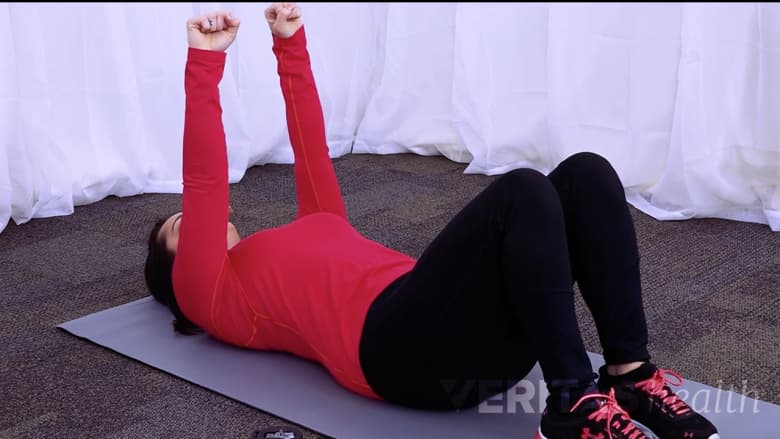Sciatica refers to nerve pain originating from the sciatic nerve roots in your lower spine. It can be caused by an injury or by several different underlying orthopedic diagnoses. So, when it comes to treating your sciatica, it is important to tailor your treatment plan to the specific medical diagnosis causing your symptoms.
If your sciatica symptoms are caused by spinal stenosis (the narrowing of space in the spine, often caused by osteoarthritis), exercises including back flexion (forward bending) may provide you with meaningful pain relief.
Back flexion stretch for sciatica from spinal stenosis
Exercises that involve stretching your lower back while you bend your spine forward may help relieve sciatica caused by spinal stenosis.1Slater J, Kolber MJ, Schellhase KC, et al. The Influence of Exercise on Perceived Pain and Disability in Patients With Lumbar Spinal Stenosis: A Systematic Review of Randomized Controlled Trials. Am J Lifestyle Med. 2015;10(2):136–147. Published 2015 Feb 16. doi:10.1177/1559827615571510,2Kim ER, Kang MH, Kim YG, Oh JS. Effects of a Home Exercise Program on the Self-report Disability Index and Gait Parameters in Patients with Lumbar Spinal Stenosis. J Phys Ther Sci. 2014;26(2):305–307. doi:10.1589/jpts.26.305 Stretching into flexion can be done in several ways.
Gentle back flexion while lying down:
- Lie on your back with your arms and legs flat on the ground.
- Gently pull your knees to your chest with both hands placed over your shins or under your thighs until you feel a comfortable stretch is in your mid and lower back.
- Hold for a few seconds while you take slow, deep breaths and gently return to the starting position.
Aim to complete 4 to 6 repetitions of this exercise.
Modifications of the back flexion stretch
You can also perform lumbar flexion (forward bending) from a sitting or standing position.
1. For back flexion while sitting, sit in a chair with your feet flat on the floor and legs shoulder-width apart.
- Lean forward, bending at your waist.
- Reach both your hands towards the floor between your knees.
- Hold this stretch for 2 to 3 seconds and return to the starting position.
For a more gentle modification, you can try this with a large, inflated stability ball. Seated, with your legs shoulder-width apart, place your hands on the stability ball directly in front of you. Slowly roll the ball out in front of you, bending from the waist. Hold for 2 to 3 seconds and then return to the starting position.
2. For back flexion while standing, stand with your feet about shoulder-width apart.
- Gently bend forward at your hip, allowing your low back to bend.
- Reach both hands down towards the floor until a comfortable stretch is felt. You should feel a stretch in your low back or in the back of your legs (hamstrings), but do not push into pain.
- Hold this position for 2 to 3 seconds and return to the starting position.
Try these stretches to see which option is comfortable for you. Once you’ve found the right stretch, try it 2 to 3 times a day to relieve sciatica pain caused by spinal stenosis.

Exercises to help alleviate the sciatica pain caused by spinal stenosis typically focus on stretching and strengthening the back muscles.
How back flexion exercises promote pain-relief
Regular flexion stretches promote:
- Temporary opening of the joint spaces in your lumbar spine
- Improved hamstring and lumbar mobility
- Relief from prolonged extended positions (standing or walking)
It is advised to learn back flexion stretches from a doctor or certified physical therapist, who can guide your form and posture. If you feel pain while performing the stretch or after engaging in this exercise, inform your treating doctor or therapist immediately.
Learn more:
- 1 Slater J, Kolber MJ, Schellhase KC, et al. The Influence of Exercise on Perceived Pain and Disability in Patients With Lumbar Spinal Stenosis: A Systematic Review of Randomized Controlled Trials. Am J Lifestyle Med. 2015;10(2):136–147. Published 2015 Feb 16. doi:10.1177/1559827615571510
- 2 Kim ER, Kang MH, Kim YG, Oh JS. Effects of a Home Exercise Program on the Self-report Disability Index and Gait Parameters in Patients with Lumbar Spinal Stenosis. J Phys Ther Sci. 2014;26(2):305–307. doi:10.1589/jpts.26.305

